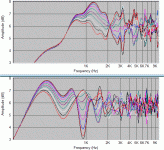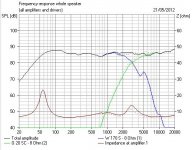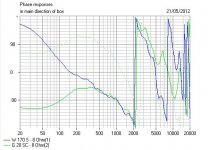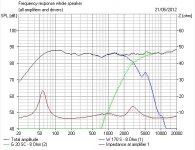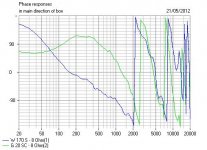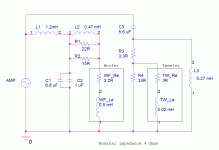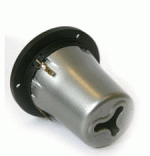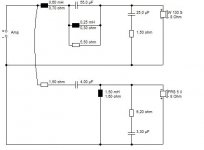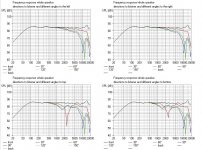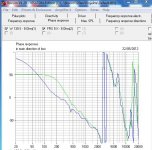I was referring to the practice of horizontally offsetting a tweeter to one side
Offsetting just one driver to the side disturbs the horizontal polar response of the speaker and is not conducive to good imaging. If you feel you must offset the tweeter then the woofer/mid should be offset by the same amount to maintain a vertical line, although I'm not in favour of such asymmetric layouts in general as they are usually done to try to combat the effects of diffraction but IMHO are the wrong approach and only improve the on axis frequency response without reducing actual diffraction in any way.
So we have slightly different preference/opinion. I'm talking about 2-way speaker, so the woofer is still in the center of the baffle, only the tweeter is offset to one side. There is still straight line, but not vertical as you suggested.
Actual diffraction and response is affected, can be clearly simulated, and is audible (that's the most important thing) and the response is easier to work with. A plus is that the tweeter has more rigid panel.
I got a good chuckle when I read that comment. You do realise that you can draw a straight line between any two points ? 😀 So that doesn't mean anything... the point is whether the drivers are vertically aligned or not.I'm talking about 2-way speaker, so the woofer is still in the center of the baffle, only the tweeter is offset to one side. There is still straight line, but not vertical as you suggested.
In the 70's and earlier you saw speakers with all kinds of weird driver arrangements - woofer at the bottom, midrange at the top left, tweeter half way up the right hand side, etc, often with left and right speakers not mirror images. Sometimes you even saw multiple mids or tweeters, and not even on the same vertical axis.
You don't see such designs anymore. Why ? Because we've learned a lot in the last 30 years...and its been realised that vertical alignment of drivers is important because the horizontal off axis response is far more important than the vertical off axis response.
There are many reasons why and a full discussion of the reasons would veer the thread way off topic, but one major one is that our hearing system is very sensitive to azimuth location of sound sources but not that sensitive to elevation. The way speakers/listener are set up in a room and the interaction with the room boundaries is another reason.
If you have to break the frequency range up into multiple physically displaced drivers, any horizontal displacement among the drivers is detrimental to the final result, while vertical displacement is the least detrimental.
Actual diffraction and response is affected, can be clearly simulated, and is audible (that's the most important thing) and the response is easier to work with. A plus is that the tweeter has more rigid panel.
Diffraction is only affected in so much as the arrival times of the impulse at each part of the baffle edge are redistributed in time, leading to a different usually flatter summed on axis response, however the overal amplitude of the diffraction signature from the baffle is not reduced, nor is the width of the apparent sound source created by the reradiated sound reduced - you still don't have a point source. You have a point source plus the outline of a box radiating.
Diffraction has not been cured, only on axis frequency response has been improved somewhat, off axis response will still have diffraction ripples. In the process of offsetting the tweeter you also alter the polar response causing asymmetric lobes in the horizontal plane.
You can't just consider the on axis measurement, you have to consider the polar response and what happens as you go off axis.
Actually eliminate diffraction and the on axis response will become flatter, the diffraction ripples off axis will go away and you can achieve a smooth symmetrical horizontal off axis response. When diffraction is eliminated you don't need any asymmetrical placement of drivers.
Last edited:
And then there is the possibility that in the older speakers that one of the two drivers in one speaker were accidentally wired out of phase either at the factory or by a subsequent user?
That would make a mess out of the "stereo" effect.
_-_-bear
That would make a mess out of the "stereo" effect.
_-_-bear
And then there is the possibility that in the older speakers that one of the two drivers in one speaker were accidentally wired out of phase either at the factory or by a subsequent user?
and even if they were wired the same way, don't trust it would be the right way at all
just recently I tried to reverse mid phase on speakers owned by a friend
and instantly he said; wow, what did you do ? 😀
I got a good chuckle when I read that comment. You do realise that you can draw a straight line between any two points ? 😀 So that doesn't mean anything... the point is whether the drivers are vertically aligned or not.
My point was not if a straight line could mean anything. My point was trying to understand your writing about straight line.
Diffraction has not been cured, only on axis frequency response has been improved somewhat, off axis response will still have diffraction ripples. In the process of offsetting the tweeter you also alter the polar response causing asymmetric lobes in the horizontal plane.
So we agree that on-axis FR has been improved somewhat. As long as theory is concerned, nothing to be disagreed. I know about these theory. What I don't know is (and this is the only thing that interest me) how much is the impact in term of audibility etc.
You are talking about asymmetric lobes in the H-plane (which is your main point here) for example. No matter how many time I read similar explanation, there's no way I can relate that into my hearing perception. Because there are so many factors at stake.
My experience only tell me that I will prefer to offset the tweeter. Probably the effect of rigid baffle (compared to the position at center) plays a bigger role than response or diffraction. But I just cannot see how polar response can be a bigger issue. I will prefer to assume that anything inaudible can be neglected 😀
You can't just consider the on axis measurement, you have to consider the polar response and what happens as you go off axis.
Of course. And we cannot only consider the technical part of it as the non-technical parts are often more important (human hearing, perception, preference). But like I said in previous post, being perfectionist is much easier than being effective.
I suppose we could more easily detect the edges of the baffle when the diffraction comes from wider apart edges. It's a good point.and it was suggested by several that......you have a first arrival from the tweeter in the middle, a second arrival from the edge that is angled closest to you (depending on speaker toe in) then shortly after that a third arrival.
If the speaker is large each one of those comes from a different horizontal azimuth location, and the human hearing system is VERY sensitive to horizontal azimuth in the front hemisphere,
I'd like to refute the premise of inferior imaging all the same.
1. The lateral sound drops in level as it traverses the baffle. I calculated the included angle for a centred point source to cover 1cm of the baffle edge at the height of the driver, for both a 20cm(8") baffle and a 60cm(2') baffle. The smaller baffle was over-represented by a factor of three... Before it gets suggested that the larger baffle gets a larger spatial representation I want to mention that diffraction perception has been shown to be level dependent.
2. There is support for the effect of delay on intelligibility improving with distance.
3. I don't believe that if diffraction is bad, that we can hide it by placing it next to the source. (Sorry about that one, but I'd have to be missing something significant 😉)
Hmm, it could be a red herring, I mean, to anyone that says to me, 'how can that speaker make the sound of a guitar when it isn't shaped like a guitar?', I say it doesn't have to. The sound of a guitar is preserved on this recording, encoded in stereo. The speakers should only talk 'stereo' to me, and if that is a competent format then I'll hear a guitar.On the other hand a true point source which is exceptionally narrow in the horizontal plane containing no correlated diffraction/reflection can only mean a sound source distance of "infinity" to any such estimation method that the brain might use. In nature only a sound source very far away would be this "narrow" in azimuth.
Anything else is either an intended or a misguided attempt to imporove our enjoyment, in my opinion.
I thought this one could use a good kick in the right direction. I simmed the effect of diffraction on the response from 1kHz and up for the 8" and 2' baffles from point 1 above. Incidentally the baffles are very tall, no edge treatment, perfect point source, and zero out to 45 at 5 degrees per.. Enjoy 😉A lot of people's ideas of dealing with diffraction are to simply horizontally offset the tweeter on the baffle and adjust the EQ of the network to compensate the on axis response to be as flat as possible.
Attachments
I just don't know why people don't sidestep this cabinet diffraction issue by integrating the speaker more with the room. Bookshelfed or inset into a wall somehow both solve it. Now all this talk of tweeter placement and imaging suggests the obvious question: Is it worth time-aligning as Michelino did?
I looked at this simple 2nd. order crossover on a paper bass and dome tweeter:
In fact frequency response changes little in this example. But phase does some dramatic things with time alignment and (inevitably...) reversing the tweeter phase. Time aligned is the second two images. Enough there to get me interested. If you wire your tweeter out of phase, you are really time-aligning here, but on a conventional speaker you'll then end up tilting it to get it to work! Sounds familiar? 🙂
(BTW, this is a very rough and ready example, I think I could do better!)
An externally hosted image should be here but it was not working when we last tested it.
I looked at this simple 2nd. order crossover on a paper bass and dome tweeter:
An externally hosted image should be here but it was not working when we last tested it.
In fact frequency response changes little in this example. But phase does some dramatic things with time alignment and (inevitably...) reversing the tweeter phase. Time aligned is the second two images. Enough there to get me interested. If you wire your tweeter out of phase, you are really time-aligning here, but on a conventional speaker you'll then end up tilting it to get it to work! Sounds familiar? 🙂
(BTW, this is a very rough and ready example, I think I could do better!)
Attachments
No, I meant inside the back-plate of the tweeter. 😉 (..there is a reason you pay more for those Scan-Speaks..)
I took off the backplate and quickly reassembled it as there's some kind of cylindrically shaped yellow fibre inside the dome that got stretched by my taking off the plate to which the dome is attached. Other than the voice coil on the dome and the gap in the magnet for it to go in there's nothing else to be seen there.
A fairly simple test is disconnecting the ATL's mid-bass drivers and mounting them in card board box's of similar size/shape (to the ATL's). (..use tape to "seal" the edges of the box.) Play them as "full-range" drivers and see if you start getting depth.
What about keeping them in the original box, disconnecting the tweeters and bypassing the XO?
I took off the backplate and quickly reassembled it as there's some kind of cylindrically shaped yellow fibre inside the dome that got stretched by my taking off the plate to which the dome is attached. Other than the voice coil on the dome and the gap in the magnet for it to go in there's nothing else to be seen there.
What about keeping them in the original box, disconnecting the tweeters and bypassing the XO?
Consider making a rear "box" (with much greater volume) for the tweeter and keeping the "yellow stuff" *out* and the back-plate *off*. Again, cardboard box + tape usually suffices for this as well for a test. (..measured performance will usually degrade, but then we aren't that concerned with it at this stage.)
Keeping them in the original box is usually the 2nd step (often routing the wire through the vent). The alternative is removing everything from the original box and then replacing it again to see if there is a difference or not. Here we are just looking at the performance of the mid-bass driver alone in a similar volume enclosure both with "stuffing" (+ other air-flow constriction) and without.
Last edited:
Thank you for the suggestions, but I probably won't be experimenting with the ATLs. I don't intend to keep them now that the minimonitors have taken their place.
I gotta enjoy people saying they hate metal cones. Flipping awful things. Supersonics to make your ears bleed! 😀
Here's the classic BBC crossover to give Jitter some ideas, really the state of the art still! You can sometimes get away with second order on the tweeter if the driver is well behaved and a RC tank across the bafflestep coil does nice things to phase while killing some breakup beyond crossover, but second order bass is essential to tame breakup modes. Notice the RCL trap to tame the bass midrange peak on small 5" drivers. {zip}
In the attachment is the XO in my new speakers... For simming in spice (of the XO), would the resistor in series with the coil that I drew be a suitable electrical equivalent of the drivers?
Attachments
Last edited:
..I don't intend to keep them now that the minimonitors have taken their place.
Understandable.
Those Scan-Speak drivers are very good both in measured performance and in this esoteric area of performance. (..their mid-bass drivers, like those from Audio Technology, are far more immune to the effects of resistance at really low excursion potential (..i.e they are mostly "box immune"). And their tweeters set pretty much the benchmark in proper damping with low air-flow resistance.)
Zaph has them measured on his site..
Zaph|Audio
Oh, another point.
most tweeters are not properly sealed and need to be placed in their own sealed, completely sealed enclosure. Otherwise the high pressures found in the woofer box can and will cause IM with the poor little tweeter diaphragm...
My take on why sound sticks to some speakers can be summed up in a simple way: bad tweeters set too high in level.
most tweeters are not properly sealed and need to be placed in their own sealed, completely sealed enclosure. Otherwise the high pressures found in the woofer box can and will cause IM with the poor little tweeter diaphragm...
My take on why sound sticks to some speakers can be summed up in a simple way: bad tweeters set too high in level.
My take on why sound sticks to some speakers can be summed up in a simple way: bad tweeters set too high in level.
Very true, bear. If it is not proper (it is the hardest part to get right), better to roll it off.
I gotta enjoy people saying they hate metal cones. Flipping awful things. Supersonics to make your ears bleed! 😀
system7 what cones material do you prefer for woofers and for tweeters ?
Oh, another point.
most tweeters are not properly sealed and need to be placed in their own sealed, completely sealed enclosure. Otherwise the high pressures found in the woofer box can and will cause IM with the poor little tweeter diaphragm...
My take on why sound sticks to some speakers can be summed up in a simple way: bad tweeters set too high in level.
Good point. The Scan Speak tweeters are sealed at the rear with an alu chamber, so this should fairly well isolate them from the pressure waves in the box. The ATL's didn't seen to have a seal between the plate and magnet.
What about sealed boxes? Do the tweeters in those suffer more from pressure waves caused by the woofer than in a vented box or is that a misconception ?
Imo, it doesn't matter, there is too much pressure in any box with any open back woofer, or midbass, or midrange driver pressurizing the air volume, sealed or ported.
Regarding the scan speak, the rear seal is NOT the whole deal. Look at it with ur eyes and a bright light. Don't count on glue, do look for any small gaps anywhere. They all add up.
The easiest thing is to add a small rear chamber that encloses the entire tweeter. PVC or heavy cardboard tube makes the job easy enough. Carpets come on heavy tubes, various suitable diameters... free from the Carpet stores.
_-_-bear
Regarding the scan speak, the rear seal is NOT the whole deal. Look at it with ur eyes and a bright light. Don't count on glue, do look for any small gaps anywhere. They all add up.
The easiest thing is to add a small rear chamber that encloses the entire tweeter. PVC or heavy cardboard tube makes the job easy enough. Carpets come on heavy tubes, various suitable diameters... free from the Carpet stores.
_-_-bear
That looks like some sort of reflex on the tweeter, jitter. You might be OK with reflex, but closed box would feed a bit of bass/mid pressure into it! FWIW, looks like a fairly straightforward second order crossover to me. 🙂
What is interesting is that you can match paper mid/bass and paper cone tweeters so the resonances and phasiness match almost exactly. I think this is because every material has its own acoustic signature, such as aluminium's horrible 27kHz resonance. I'm playing with a very pricey crossover with some Visaton paper cones in Boxsim in a 7-20L wall mounted time-aligned closed-box bookshelf design, and frankly, I am loving what I am seeing here! This is remarkable IMO. 😀
I am no expert on this, Iduarte, but I have a hierarchy of worsening materials in my mind. Mineral filled Polycone, paper, cellulose, kevlar, glass fibre, aluminium, beryllium. Personally, paper combines lightness and speed with near optimal damping in my mind. I always find polycones a bit sluggish. Metal, well, fageddaboudid! 🙄system7 what cones material do you prefer for woofers and for tweeters ?
What is interesting is that you can match paper mid/bass and paper cone tweeters so the resonances and phasiness match almost exactly. I think this is because every material has its own acoustic signature, such as aluminium's horrible 27kHz resonance. I'm playing with a very pricey crossover with some Visaton paper cones in Boxsim in a 7-20L wall mounted time-aligned closed-box bookshelf design, and frankly, I am loving what I am seeing here! This is remarkable IMO. 😀
Attachments
- Status
- Not open for further replies.
- Home
- Loudspeakers
- Multi-Way
- what makes sound "stick" to speakers?
